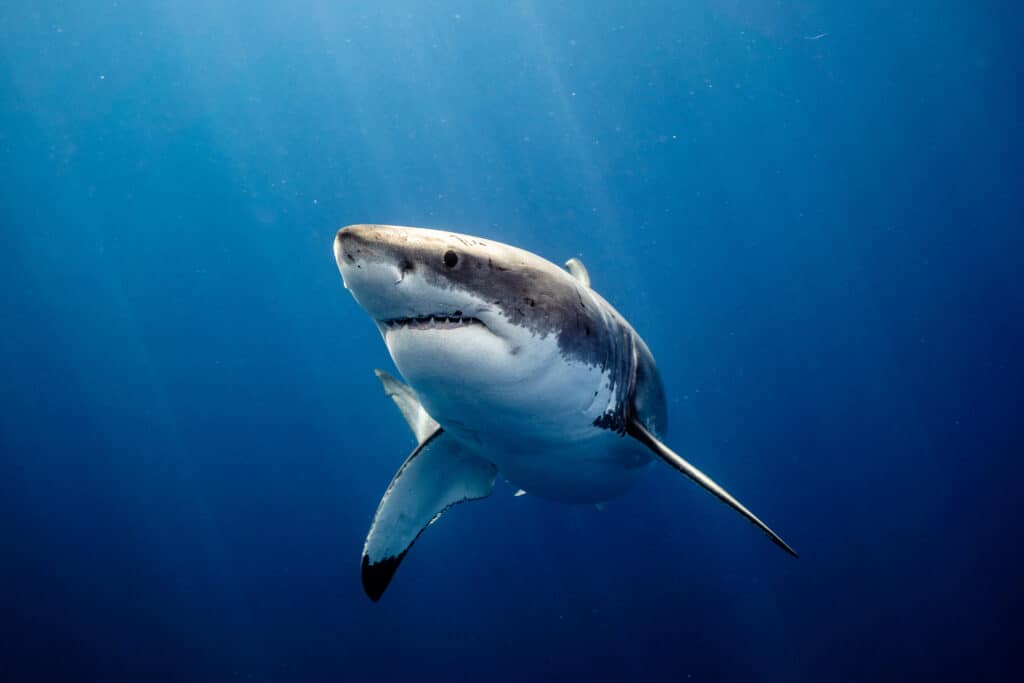With an average monthly temperature of 50°F, the beaches in Virginia Beach, Virginia, aren’t exactly crowded in January. But in late January 2023, one rather unexpected tourist showed up for a swim off Virginia Beach’s coast: a 10+ foot-long Carcharodon carcharias, more commonly known as a great white shark!

A great white shark was detected off Virginia’s coast in January 2023.
©Jsegalexplore/Shutterstock.com
Get to Know Miss May
This specific shark has been affectionately named Miss May by OCEARCH, a global nonprofit organization dedicated to studying and preserving white sharks as apex predators and balance-keepers of the world’s oceans. Miss May was the first shark ever tagged by OCEARCH’s Northwest Atlantic Shared Foraging Area (NASFA) expedition.
The shark was tagged about 40 miles offshore from Mayport, Florida, hence the name “Miss May.” The female great white shark was 10 feet 2 inches long and weighed 846 pounds at her tagging. She also had a wound on her tail fin that researchers estimated was a few weeks old. The wound could have been sustained when the shark got wrapped up in a longline, or it may have been inflicted by a bite from a larger shark. However the wound happened, it will ensure Miss May is instantly recognizable if researchers ever spot her again.
The shark was tagged on February 15, 2019. Since then, Miss May has proven herself to be quite the traveler. According to OCEARCH’s tracking data, the shark has swum more than 15,500 miles since her tagging in early 2019.
Miss May has traveled as far north as Cape Cod Bay in Massachusetts. Her southern journeys have taken her to the coast of Cuba. Miss May’s latest tracker ping revealed that she was visiting the waters off Virginia Beach’s coast on January 27, 2023.
The trackers placed on sharks like Miss May send a signal when the shark surfaces. The wet/dry switch on the device must remain dry for a minimum of 90 seconds as the shark cruises at the water’s surface. This allows for three consecutive pings, which are necessary to give researchers accurate geo-positioning information.

Miss May has been hanging out off the Virginia coast.
©BestStockFoto/Shutterstock.com
Time to Panic?
Virginia beachgoers have little to worry about with Miss May’s presence, even if she were to show up again in the summer when the beaches are packed with people. Since 1852, there have been only five shark bites in Virginia Beach’s waters, only one of which was fatal. In short, you’re more likely to be struck by lightning than to be attacked by a shark in Virginia’s coastal waters.
Most of the sharks near Virginia Beach are sandbar sharks (Carcharhinus plumbeus), also known as brown sharks. These sharks can grow up to eight feet in length and are popular targets for sport and commercial fishing. Sandbar sharks are commonly caught near the Virginia Beach Fishing Pier.
Great white sharks, however, are more of a rarity and are normally found further off the coast. Miss May and some of her fellow tagged great white sharks do occasionally make their way through the waters off of Virginia’s coast, but they don’t often linger. Sightings are much more common further down the Atlantic seaboard. While South Africa boasts the world’s largest population of great white sharks, New Smyrna Beach in Volusia County, Florida leads the world in human and great white shark encounters.

Sandbar sharks are much more common than great whites in Virginia Beach waters.
©iStock.com/Schnapps2012
Why Do Attacks Happen?
It’s important to note that great white sharks don’t purposefully hunt humans. When a rare great white shark attack does happen, it’s often a case of mistaken identity.
As the largest predatory fish in the ocean, the great white shark’s typical diet consists of sea turtles, sea lions, seals, porpoises, dolphins, small whales, and fish. As a human swimmer splashes about in the water, it can attract the attention of a shark that mistakes the person for a fish or some other preferred prey. This is why when a shark does bite a person, usually an arm or a leg, it often quickly releases, realizing that the human is not the prey animal it was seeking.
This is not the case every time, of course. Sharks are wild predators, so they are wholly unpredictable by their very nature. While rare, injuries and fatalities do happen. When we step into the ocean’s water, we enter a world not our own. It is a world where the shark, specifically the great white shark, rules.

Rare attacks on humans typically happen when the shark mistakes the human for its natural prey.
©iStock.com/USO
The photo featured at the top of this post is © iStock.com/ShaneMyersPhoto
Thank you for reading! Have some feedback for us? Contact the AZ Animals editorial team.






